
Piscataway is an unincorporated community in Prince George's County, Maryland, United States. It is one of the oldest European-colonized communities in the state. The Piscataway Creek provided sea transportation for export of tobacco. It is located near the prior Piscataway tribe village of Kittamaqundi.

The William Paca House is an 18th-century Georgian mansion in Annapolis, Maryland, United States. Founding Father William Paca was a signatory of the Declaration of Independence and a three-term Governor of Maryland. The house was built between 1763 and 1765 and its architecture was largely designed by Paca himself. The 2-acre (8,100 m2) walled garden, which includes a two-story summer house, has been restored to its original state.

Snow Hill is a manor house located south of Laurel, Maryland, off Maryland Route 197, in Prince George's County. Built between 1799 and 1801, the 1+1⁄2-story brick house is rectangular, with a gambrel roof, interior end chimneys, and shed dormers. It has a center entrance with transom and a small gabled porch. A central hall plan was used, with elaborate interior and corner cupboards. The original south wing was removed and rebuilt, and the home restored in 1940. The Late Georgian style house was the home of Samuel Snowden, part owner of extensive family ironworks, inherited from his father Richard Snowden. and is now owned and operated by the Maryland-National Capital Park and Planning Commission as a rental facility.

The George Washington House, or Indian Queen Tavern, is located at Baltimore Avenue, at Upshur Street, in Bladensburg, Prince George's County, Maryland. It was constructed in the 1760s. The 2+1⁄2-story structure is constructed of brick Flemish bond on ends. The plan is rectangular, with a gabled roof, exterior end chimneys, gabled shingled dormers. There are first and second-story center entrances, each with a transom. There is a full-width one-story porch with balustraded deck and side entrances. The structure includes a later two-story rear addition. The structure is Georgian.
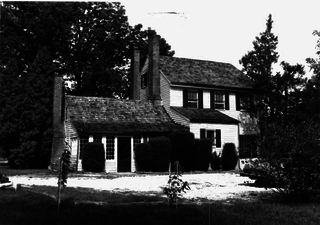
Bellevue is a historic plantation house located at 200 Manning Road East, in Accokeek, Prince George's County, Maryland, United States. This Greek Revival style home was constructed in about 1840. It is one of only three surviving examples in Prince George's County of the once-popular Tidewater house style, typical of successful small plantations of that period. Bellevue is in excellent condition, and retains its freestanding chimneys with brick pent, as well as a roughly contemporary kitchen wing. The house stands on a five-acre, partially wooded lot which exemplifies its original plantation setting.

Bostwick is a historic home located a short distance below Lowndes Hill, the present-day property of Bladensburg Elementary School in Bladensburg, Prince George's County, Maryland, United States. According to its date plaque, it was built in 1746 by Christopher Lowndes (1713-1785). The house was later the home of Lowndes’ son-in-law, Benjamin Stoddert (1751-1813), first Secretary of the Navy. Colonel Thomas H. Barclay resided at "Bostwick," the oldest surviving structure at Bladensburg. Located nearby is the Market Master's House, also built by Lowndes.

Abraham Hall, constructed in 1889, is located on the northeast side of Old Muirkirk Road in the center of the historic African American community of Rossville, a section of Prince George's County, Maryland near Beltsville.

The William W. Early House is a Queen Anne-style house located at Brandywine in Prince George's County, Maryland, United States, and is privately owned. It was constructed in 1907. According to a 1989 Historic American Buildings Survey report on the house, "The William W. Early House is probably the best example of turn-of-the-century Queen Anne-style domestic architecture in the county."

Bowling Heights is a historic home located in Upper Marlboro, Prince George's County, Maryland, United States. It is a large 2+1⁄2-story frame house constructed in 1877 in the High Victorian Gothic style.

Compton Bassett is a historic home in Upper Marlboro, Prince George's County, Maryland, United States, that was constructed ca. 1783. It is a two-story brick Georgian house, covered with cream-colored stucco, on a high basement of gray stucco. A two-story wing was added in 1928. Remaining outbuildings include a chapel to the southeast, a meat-house to the southwest, and a dairy to the northwest. Also on the property is a family burial ground.

Content, also known as the Bowling House, is a historic home located in Upper Marlboro, Prince George's County, Maryland, United States, across the street from the county courthouse. The home is a 2+1⁄2-story, two-part frame structure built in three stages. The first section, built in 1787, consisted of the present main block, with a stair hall and porch added ca. 1800. A north wing was added before 1844. Content is one of the oldest buildings remaining in the county seat of Upper Marlboro, along with Kingston and the Buck House. Content has always been owned by prominent families in the civic, economic, and social affairs of town, county, and state including the Magruder, Beanes, and Lee families; and the Bowling and Smith families of the 20th century.

The Thomas J. Calloway House, constructed in 1910, stands on the south side of Elm Street adjacent to Crescent Avenue in the traditionally African-American neighborhood of Lincoln in Lanham, Prince George's County, Maryland. It is credited to Isaiah T. Hatton, an early African-American architect.

The Cottage is a 19th-century plantation complex located near Upper Marlboro in Prince George's County, Maryland. The complex consists of the principal three-part plantation house with its grouping of domestic outbuildings and four tenant farms, scattered over 282 acres (114 ha). The plantation house has a 2+1⁄2-story main block constructed in the 1840s with a typical Greek Revival style interior trim and distinctive Italianate cornice brackets. Within 150 feet (46 m) to the northwest of the house is a complex of domestic outbuildings, including a well house, ice house, and meat house. It was the home of Charles Clagett (1819–1894), a prominent member of Upper Marlboro social and political society during the second half of the 19th century. He served as a county commissioner following the Civil War.

Hazelwood is a historic home located outside Upper Marlboro, Prince George's County, Maryland, United States. The home is a large asymmetrical frame dwelling, built in three discrete sections over a long period of time. They are: a low gambrel-roofed section dating from the 18th century, about 1770; a gable-roofed Federal-style dwelling dating from the very early 19th century; and a tall gable-front Italianate-style central section constructed about 1860. The house stands on high ground west of and overlooking the site of historic Queen Anne town on the Patuxent River. Also on the property are several domestic and agricultural outbuildings, and the reputed sites of two cemeteries.
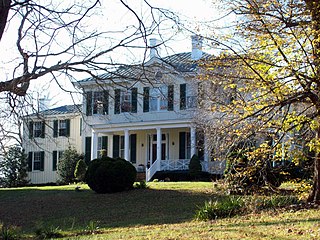
Waverly is a historic home located at Croom in Prince George's County, Maryland. The house, constructed in 1855, is a 2+1⁄2-story, two-part Italianate-style frame house. The casing of the principal entrance is a combination of both the Greek Revival and Italianate styles. Also on the property are two of the original outbuildings, a meathouse and a washhouse.
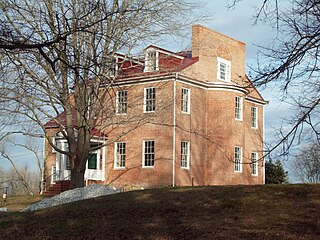
Melford is a historic plantation house located on the grounds of the Maryland Science and Technology Center, near the intersection of U.S. Route 301 and U.S. Route 50, at Bowie, Prince George's County, Maryland. The house is multi-part, gable-roofed, brick and stone dwelling house constructed probably in the mid-late 1840s, with elements of the Greek Revival style.
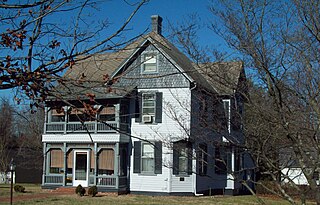
The John H. Traband House is a historic home located at Upper Marlboro in Prince George's County, Maryland, United States. It was built between 1895 and 1897, and is a 2+1⁄2-story, asymmetrically shaped Queen Anne influenced frame structure of modest size and detailing. Also located on the property are a frame two-story gable-roofed carriage house. The house was constructed as the residence of a prominent citizen, John H. Traband (1857–1938), who was a successful businessman and landholder in Upper Marlboro.

The Hyattsville Historic District is a residential neighborhood comprising a national historic district located in the city of Hyattsville, Prince George's County, Maryland. The district comprises approximately 600 structures, primarily houses, that exhibit late-19th and early-20th century design characteristics. The majority of residential buildings are of frame construction, the older ones with foundations of brick or (rarely) fieldstone, the newer of concrete. The architectural styles represented: grand "mansions," summer cottages, duplexes, Second Empire, Queen Anne, Italianate, Victorian, Bungalow, and Spanish. The area also includes numerous vernacular buildings. The finest concentration of late-19th century structures occur in the area of Farragut, Gallatin, and Hamilton streets and 42nd Avenue. The early-20th century hipped-roof style and bungalows are found throughout the district.
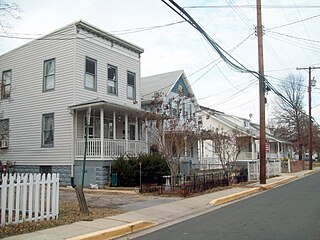
The North Brentwood Historic District, is a national historic district located in the town of North Brentwood, Prince George's County, Maryland. It was the earliest incorporated African American community in the county. The historic district comprises 128 buildings reflecting its development over the period from 1891 to 1950. All of the early vernacular dwellings were of wood-frame construction with Late Victorian inspiration. The 1920s house forms represented included bungalows, multi-family houses, and larger Foursquares. Small brick cottages were primarily built in the period immediately following World War II. The surviving historic buildings illustrate the forms and styles of buildings typically constructed in working-class suburban communities of the period.

The Clagett House at Cool Spring Manor is a historic house in Prince George's County, Maryland, built around 1830 by William Digges Clagett on the family's Cool Spring Manor property. Constructed in a style more typical of the Deep South, it is a hip roofed wood frame dwelling standing on a brick foundation.























